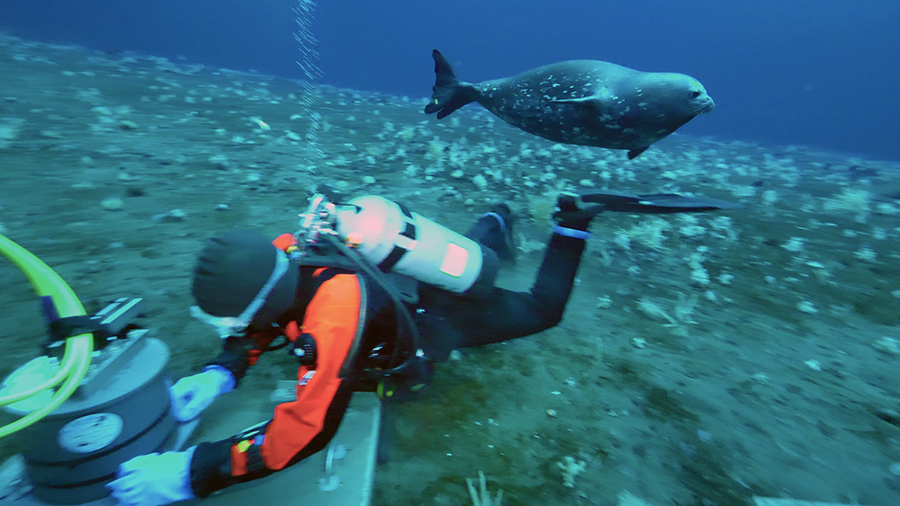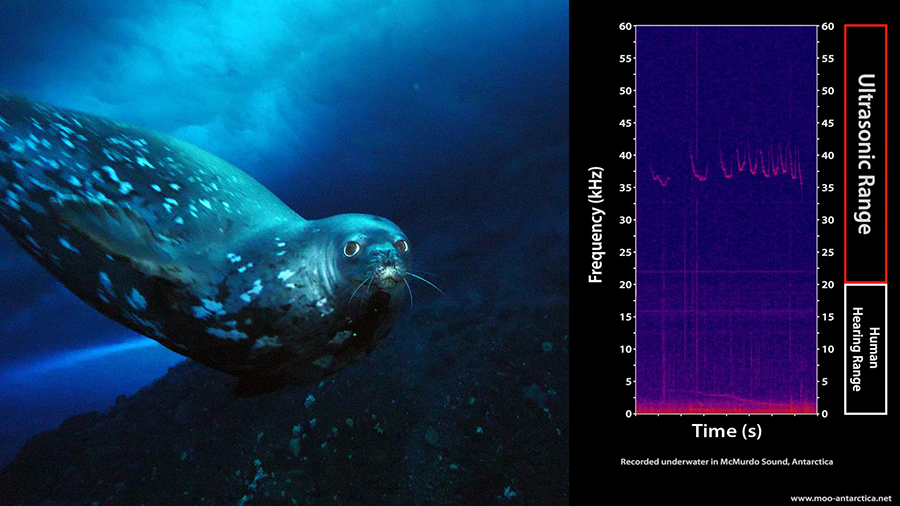Weddell Seals Sing Songs Humans Can't HearNew Research Unveils the Ultrasonic Calls of Weddell SealsPosted January 18, 2021
The seals of McMurdo Sound are more vocal than previously thought. A new research paper published in the December edition of The Journal of the Acoustical Society of America shows that Weddell seals vocalize underwater at frequencies too high for humans to hear. It's the first time the extent of these high-frequency sounds have been identified, though scientists aren't yet sure what the seals use them for. 
Photo Credit: Paul Cziko
Paul Cziko dives under the frozen ice to install the McMurdo Oceanographic Observatory, also known as the MOO.
"You never know what you're going to find when you've got eyes and ears in the ocean, especially in Antarctica," said Paul Cziko, an ecologist at the University of Oregon and lead author of the research paper. The research is supported by the National Science Foundation, which manages the U.S. Antarctic Program. Sonic SealsWeddell seals are ubiquitous around McMurdo Sound. They are the southernmost mammal, and there are several pupping colonies throughout the region where females congregate atop the sea ice to raise their young. Able to dive for nearly an hour and a half, they use cracks and holes in the ice to come up for air when they go hunting for fish. "Weddell seals really are amazing animals. They inhabit some of the most inhospitable, cold and icy areas of the planet. They always seem to be totally at ease, both on and under the sea ice," Cziko said. The sounds were recorded by the McMurdo Oceanographic Observatory, or MOO, a cluster of instruments that monitored McMurdo Sound from November 2017 through November 2019. Installed off the coast from McMurdo Station, the observatory was equipped with salinity, temperature, and tidal pressure detectors, a 360-degree swiveling camera, and a microphone designed to operate underwater known as a hydrophone. "Studying the ocean, especially remote or hard-to-access environments, is quite a challenge. Advances in technology like the MOO show us that there is still so much to learn and discover," said Lisa Munger, a marine biologist at the University of Oregon who co-authored the study. This hydrophone continuously recorded the underwater noises of McMurdo Sound throughout its two-year operation, tuned to both audible frequencies and ones higher pitched than what humans can hear. It recorded everything from the cracking of the sea ice and whale songs to scuba divers swimming and vehicles driving over the icy surface. Weddell seals are well known to make a lot of ethereal noises while swimming. 
Photo Credit: Paul Cziko
A Weddell seal swims by Paul Cziko as he installs the MOO at the bottom of McMurdo Sound.
"The Weddell seals' calls create an almost unbelievable, otherworldly soundscape under the ice," Cziko said. "It really sounds like you're in the middle of a space battle in Star Wars, laser beams and all." Up to now, scientists generally believed that pinnipeds, the biological group that includes seals, sea lions and walrus, vocalize only at sonic, human audible, sound frequencies. But after carefully analyzing visual graphs of the hydrophone's recorded audio, known as "spectrograms," the research team repeatedly encountered biological sounds that were too high-pitched for humans to hear. "We spent countless hours in the lab listening to the live audio feed and watching the scrolling spectrogram and, every now and then, looking at each other, and saying ‘What was that sound?'" Munger said. "We kept coming across these ultrasonic call types in the data. Finally, it dawned on us that the seals were actually using them quite regularly." The clincher came when they caught a Weddell seal making its vocalizations while on camera. "We certainly expected that it was the Weddell seals making these ultrasonic sounds. When we saw a seal swim by the camera while making a call, that was the icing on the cake," Cziko said. Previous researchers had seen a few hints that Weddell seals make some form of ultrasonic sounds underwater, but this was the first study to see the scope of just how often they use them. "Researchers have been listening to the sounds of Weddell seals for a long time," Cziko said. "[But] earlier recording equipment was limited, cumbersome at high frequencies, and long-term recordings were very difficult." 
Photo Credit: Paul Cziko
On the left, a Weddell seal swims by the camera of the MOO while emitting ultrasonic sounds. On the right, the sonogram displays all of the noises recorded by the hydrophone, including those outside the range of human hearing.
The team identified nine distinct ultrasonic calls made by seals, including an assortment of what they described as "chirps, whistles and trills" when the soundwaves were shifted down into the human hearing range. They recorded calls reaching frequencies as high as 50 kilohertz. Humans, by comparison, can only detect soundwaves with frequencies below about 20 kilohertz. Ultrasonic UtilityWhat the seals use these ultrasonic sounds for is unclear. The most prosaic explanation is that the seals use them to communicate with other seals just as they do with their more audible calls. "These seals make such a racket at the lower frequencies. It's possible that these high-frequency sounds allow them to stand out over all the lower-frequency noise. Like changing to a different channel for communicating," Cziko said. However, the seals may be using these vocalizations for echolocation as whales and dolphins do. Those creatures use soundwaves to navigate by emitting a brief, high-frequency noise and listening to where the sound waves bounce off of solid objects in the water. More research is needed to confirm whether Weddell seals are likewise echolocating. If so, it would be the first time a pinniped has been identified using echolocation to navigate underwater. "We still have almost no idea of how these seals navigate and find prey under ice, especially when it's completely dark during the Antarctic winter," Cziko said. "Our hunch is that these sounds that they make are one piece of the puzzle." If confirmed, it could help answer one of the persistent mysteries of Weddell seals, namely how they're able to navigate to hunt and find small breathing holes in the ice during the long, dark Antarctic winters. "Most researchers say these seals just use their sensitive vision to find prey and navigate. Like, by following features in the sea ice overhead and by backlighting prey against the sun," Cziko said. "No one has an explanation for how the seals succeed when it's nearly or completely dark under the ice, like during the long Antarctic winter." 
Photo Credit: Mike Lucibella
A Weddell seal sticks its head out of the water to take a breath through a hole in the ice. How they're able to find such small holes and cracks during the dark Antarctic winter remains a mystery.
However, the seals' physiology, as well as the nature of the recorded sounds, might make for imperfect echolocation. The animals themselves don't seem to have the specialized internal structures in their body to track the direction of incoming echoes with high accuracy as other marine echolocators do. Whales and dolphins also use very quick, high-frequency clicks to pinpoint objects in the water, while the sounds found by Cziko and his team last much longer, limiting their precision. "Based on what we know now, any echolocation ability that the seals have would probably still be much inferior to the abilities of dolphins and other toothed whales," Cziko said. "Proving whether or not seals use their sounds for echolocation is going to be difficult. But, we now know that this one species has one more of the necessary acoustic tools in its toolbox." Though tantalizing, there's more that the researchers are keen to understand about these seal sounds before they can come to any final conclusions about them. "We'd like to know who is producing the ultrasonic calls - males, females, juveniles, or all of the above? And, how are the seals using these sounds when they're out in deeper water, looking for fish?" Munger said. "We need to record in more places to be able to correlate sounds with behaviors." They hope that future investigations might be able to decode the functions of these mysterious noises from the deep. "This really shows the benefits of having eyes and ears continuously underwater. These small underwater observatories could really help revolutionize our understanding of the oceans," Cziko said. NSF-funded research in this story: Paul Cziko, University of Oregon, Award No. 1644196. |
"News about the USAP, the Ice, and the People"



For USAP Participants |
For The Public |
For Researchers and EducatorsContact UsU.S. National Science FoundationOffice of Polar Programs Geosciences Directorate 2415 Eisenhower Avenue, Suite W7100 Alexandria, VA 22314 Sign up for the NSF Office of Polar Programs newsletter and events. Feedback Form |


